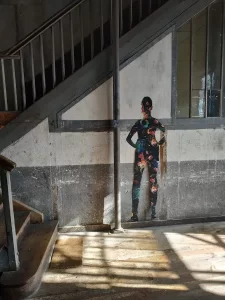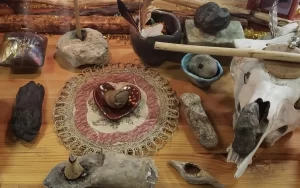On a recent visit to the UK, I read in a magazine that “mental health is the new physical health.” In my personal and professional life, I have definitely found that mental health is the foundation for overall wellness. Relationships seem to be the main weather gauge for what is happening in our inner lives.
In this article I want to focus on our primary relationship with the world, the relationship with the mother. As infants, we do not doubt the unconditional love that we have from our mothers. They are our lifeline. This unquestioning trust goes without saying throughout our childhood. However, as in all archetypal relationships there exists a negative aspect to the mother and this is becoming more and more prevalent. This manifestation is known as the ‘Death Mother’. Marion Woodman has written about it extensively in her book ‘Addiction to Perfection.’ She has also given a great interview with Daniela Sieff in which she elaborates on this archetype entitled “Confronting the Death Mother.”
So, what is the Death Mother? The Death Mother is a powerful aspect of the mother archetype that is dominated by the conviction that her children exist to serve her. A mother can be possessed by the Death Mother archetype and like all possessions she is completely unconscious of it. Her motivations are cannily disguised from everyone, even from herself. This archetype is called the Death Mother because she has so much deep, emotional control over the child that she can literally ‘turn her to stone’, like Medusa.
“Worse than being unseen is growing up with a parent who wishes that we or some part of us didn’t exist. The energy manifest by such a parent is symbolized by the archetype of the ‘Death Mother.’ It is a deadening energy which permeates both psyche and body, turning it to stone. It stifles growth and imprints our cells with profound fear and hopelessness. In time our vitality drains away, and we find ourselves yearning for the oblivion of death. Ultimately, our body may turn against itself, as it does with cancer and auto-immune disease.” (1)
My own mother, who I had to finally accept was a ‘Death Mother’, would give me ‘that look’ and I was paralyzed on the spot. My life force and motivation would instantly drain away and all I could do would be to retreat into myself.
She would give me ‘that look’ at moments when I was excited about something or doing something passionately that did not fit into her ideal or her opinion of who I should be and what I should be doing. The child gets the message that she is not loved for who she is. She is loved conditionally, that is only when she obeys and fits in to the rigid ‘ideal’ the mother has for her, which serves the needs of the mother, not the child.
The Death Mother tells her what to love, what to think, how to be, who to connect with, what to accept from others, what to want for the future, etc. I remember realizing as an adolescent that when I was born my mum had a ‘dream’ of how she wanted me to be and she saw only this dream and not who I was in reality. The real me had great difficulty surviving. What is not seen and mirrored back to the child cannot thrive. A deep rage begins to build within as the child feels the mother wants a part of her to die.
The Death Mother tells us that everything she is doing is ‘for our own good’, because ‘she loves us so much’ or “she only wants the best for us”. This is a double bind. We need the love of our mothers in order to thrive and survive. They tell us they love us, and they are doing everything for us, but deep down we are aware that they do not accept and do not want a part of us to exist – this a huge dilemma that can make us feel like we’re the crazy ones.
Marion Woodman explains that when a child realizes that we threaten our mother’s reality just by being ourselves or we are rejected for who we are, “our nervous system will become hyper-vigilant. Our cells will have been imprinted with a profound sense of abandonment; as a consequence, our body will numb out the moment we feel threatened. As soon as we realize we are no longer pleasing somebody, we freeze; we are thrown back into our belief that we are unlovable, which then activates our ever-present, but unconscious terror of annihilation…if there is unconscious hostility in the environment, the inner body, acting autonomously, retreats and falls over ‘dead.’ At the same time we may develop defense mechanisms that manifest in an armor of fat, edema, vomiting, anything to keep the poison out. Ultimately, our body may turn against itself as it does with cancer and auto-immune disease. Death Mother has been incorporated into the fabric of our cell.”
I believe the Death Mother is the manifestation of a wounded mother, a mother who has not been able to face, integrate and work through her own traumas and story. To survive without confronting her wound, she must control the narrative that her own daughter brings to the world. This becomes all-consuming and more important to her than her own daughter’s unique being and well-being. She forfeits her daughter’s soul journey for her own survival.
My mum, born into a mixed-race lineage from India carried our ancestral wound, which was intensified when they came to England in the thirties. Both her own mother and sister were subjected to racism from within their own family and from the outer world. My mum, who could pass as white, married an English man and decided that I would be more English than the English. She lied about our roots and every time I showed any form of behavior that she considered unfit for her fantasy, I was turned to stone.
The rage that burns in the growing child is very difficult to deal with because it comes from the unconscious. The child is not aware of why she holds so much rage and why she feels so many conflicting feelings about her mother. She so wants her mother to accept her, to acknowledge her for who she really is, for her true vibrant life energy. Unfortunately, the death mother needs to control the child and mold her into the acceptable form.
Imprisoned by the rigid, controlling, conditional love, the deep, inner rage of the child grows.
Abandonment is a deep part of what is felt from the Death Mother. We are abandoned and replaced by a cardboard cut-out of what she wants us to be. The theme of abandonment often follows us into life. We have learnt not to trust love because the most important relationship of love was thwarted. I remember being terrified of doing anything that I really felt passion or love for. I would not be able to go for the activity I wanted to do, the job or course I loved, the boy I really liked, etc. I was so paralyzed by the idea of being rejected and abandoned that I would prefer to do the things that weren’t really important. I would always make sure everyone chose first and I would choose what I thought others wanted me to choose. The core of myself had withered away and I had learned that others were more important than myself and I only existed in relation to them. This is called co-dependency. I finished by abandoning myself.
Marion Woodman explains that the impulse to grow is natural and we cannot get away from it. However, if the death mother prevents us from growing healthily and organically, this impulse will find another way to manifest. This could be in the form of cancer or putting on a lot of weight for example.
“…the imperative to grow will find a way to become manifest, and if we don’t allow it to happen in its authentic domain, it looks for expression in the concrete world, with potentially tragic consequences.”
The subliminal message that the child receives from birth is that if her soul comes out it will be killed.
As the child becomes an adult, she aims for things in live that are not what her soul is really asking for. She continues to perform as an adult, striving for goals that are not really her own. It does not matter if she has contact with her actual mother or not, as she has internalized this voice. It has parasited her. Marion Woodman says that the problem with striving for goals that are not our real goals leads to frustration as these goals do not satisfy our souls. She says, this feeling of never being satisfied by our striving in life often leads to addictive behavior.

Something has been taken from us, our sense of Self, of belonging, of authenticity, our connection with our own souls. It is these feelings that create a ‘death wish’ in order to remove us from the deepest pain of being cut off from ourselves. This cut-off-ness is so painful, because it comes from the very energy that is meant to nurture us as we grow into ourselves and we internalized the message that we would die if we were ourselves. We learn that we will be happy and have harmonious lives and this inner pain will go away if we deny our true feelings that must be bad and unacceptable and become perfect. This is what Woodman referred to as the ‘Addiction to Perfection’, which many girls and women suffer from. In order to be perfect, we need to control the world around us and others. We believe that in order to survive we must control all aspects of our lives, our families, our bodies, our jobs. We never stop always trying to achieve that impossible goal. We replace love with power and control.
The journey of healing aims at unearthing the hidden parts of the Self, to bring life back to the frozen aspects of the soul. This demands a long and in-depth examination of our own psyche. We must become our own mother and learn to love those parts of ourselves and accept that love, so we may come back to life and become whole.
Remember that the Death Mother does not leave us when we leave her home. We have internalized her – she is within us. She has become an inner tyrant controlling us from within.
Aromatics and plant medicine can be great allies. There is a lot to work through to start to heal the scars and negative beliefs installed by the death mother. It is though getting to know ourselves and belonging to ourselves that one day we will be able to look her in the eye without turning to stone.
The work starts with a change of perspective – looking within rather than blaming others.
Labdanum (Cistus ladanifer) essential oil (or absolute) is a good starting point, because the parts of ourselves that did not fit into the needs and desires of the Death Mother have been relinquished to the shadow. We need to shine the light on these parts, give them a voice and allow them to come to life.
Labdanum is the Master of the Shadow. It’s able to dig down deep and find those buried parts of ourselves that are asking to be integrated and expressed. Use a journal and labdanum absolute and ask for these parts of yourself to surface. You may feel it first as a flutter, a vague sensation that only gradually brings words and form with it. Honor these parts of yourself and love them and welcome them – all of you is welcome now.
Rose Attar is a beautiful oil for accompanying the newly born self in this healing journey. For those of us that have had to confront the violence of the Death Mother and the fragility of those deeply hidden aspects of the self, rose attar brings a safety, a nurturance, an unconditionally loving feeling. When I first discovered this oil in India, I was exploring the parts of myself and my roots that had been denied me for most of my life, the rose attar symbolized the mother and India. I kept it in my pocket for months, I had to have it on me at all times. It represented everything I was trying to heal and piece together. It still is one of my go-to oils when I need love and comfort.
At the same time as journaling, I also worked with my dreams, which are a great way of learning to communicate with the unconscious. I would leave a bottle of essential oil open by my bed and make an intention to have a dream that would help me to move forward. I often left a bottle of Yarrow essential oil open. Yarrow is like an inner teacher, a voice of wisdom. Its protective ability creates a strong bubble around us, which allows the inner work of alignment and learning from our experience and individual story to take place. Often referred to as the Wounded Healer in plant form, we must remember that the healing work we do and the wound we confront can eventually become our gift and medicine to the world. Try and remember your dreams and write them down. Then you can start to work with them. (More about dream work in a future article…)
Collage is another one of my allies in this work. Really any technique that connects us in communication with our unconscious can be helpful. With collage, I smell essential oils while tuning into the part of myself that is crying out for expression. With this work, I kept feeling my womb area burning, crying out. I would choose an oil to help me feel that feeling. Tuberose Attar or Jasmine Attar are great for this as they help us to feel our bodily sensations. I would allow the feeling to guide me as I chose images from magazines and other sources. Once I had enough images, the feeling would then guide me to where to place the images on the collage – no mind, just led by feeling. When and only when the collage is finished would I stand back and use my analytical mind to see what I could see and understand from it. What came up from the unconscious was always revelatory.
I would do the same with poetry.
I noticed after a while how the patterns coming through in collage, dreams, journaling, poetry had a coherence – they belonged together. It was always a similar message yet in a different form. I also noticed a correlation between the message and the ancestral wounds on my mother line. My mother had taken on the Death Mother as a survival technique in order to deny and hide our ancestral story. Or maybe a better way of seeing this is that she was controlled by the unconscious forces that had not been healed and integrated from our ancestral wound.
This made a lot of sense as I not only developed cancer in my female reproductive organs where I had felt the years of burning up rage, but I felt strongly connected to the hidden aspects of my maternal bloodline. In trying to kill my calling she had made it my belonging.
Marion Woodman says, “Death Mother is born out of despair. It is incubated by the crushed hope of an unlived life. Death Mother is the shadow side of disappointment. When you look into the eyes of death mother you see they are glazed over with hopelessness. You see a blank look; there is nobody at home. You see an unconscious, frozen and profoundly wounded body-psyche devoid of authentic feeling. You see somebody with desperate need to be in control. You see someone who is driven by will power.”
We must look within, become conscious of and own the Death Mother that has taken us over. If we do not do this, we will become a Death Mother to others without realizing it. Or we may feel something is wrong inside but be unable to control it. We need to look at how the Death Mother has affected all aspects of our psyche, physical, emotional, mental, spiritual and the collective.
By looking at how we were mothered and how we mother we can begin to bring awareness to this important archetype within us.
Use Lavender essential oil (Lavandula angustifolia) for these exercises. Lavender is associated with the mother energy. She is deep and light at the same time. She brings the best out in other oils in blends and helps oils work together. Lavender is reassuring, safe and familiar, helping us to align with ourselves and stay centered. She has a calming ability while at the same time maintaining a certain mental lucidity and clarity. As in her physical actions, she acts in a huge variety of situations. She is also able to help the soul navigate many different experiences. Her softness is supported by a maturity and depth that helps us love and accept ourselves. She keeps everything balanced and harmonious.
“Lavender has a moderating temperament that aims at getting along with everyone. Avoiding disputes, lavender re-establishes balance through reconciliation.” (2)
Journaling exercise: Think about and feel into your own experience as a daughter. This doesn’t mean only your biological mother, but any person in your life that has mothered you. Journal about the positive mothering you received and the negative mothering you received. Journal about the negative and positive ways that you were nurtured, empowered, protected and Initiated by the mother energy.
Next start to journal about how you mother others positively and how you mother others negatively or unconsciously. This does not have to be your children (and you don’t even have to have children) but can be any person in your life that you have mothered, consciously or unconsciously.
As women we carry within us the unhealed wounds of past generations—the unfinished business, the secrets that were never told. We can be carrying, consciously and unconsciously, both an archetypal collective inheritance from our community, society and/or ecosystem and our own personal inheritance, i.e. events or traumas inherited from our family and lineage, such as historical trauma.
Journal about issues, emotions and patterns that you can see being repeated in your life, which you may be carrying from your mother, grandmothers and great grandmothers. To help you, you can make a quaternity divided into emotional burdens, unfulfilled dreams, unfinished business, wounds.
Journal about the following two questions:
Who is the woman my mother and the society I grew up in bought me up to be?
Who is the woman I am called to be?
Again, I invite you to honor the woman you are being called to be in her entirety, her light and dark, her hardness and gentleness, her strength and fragility. We must honor and embrace all of her.
Reflect on the different exercises and what came up for you and continue the themes in your journal. The mother archetype and its complexes have a profound impact on each of us. The exercises presented here are just one way in to gain more awareness, understanding and self-compassion.
The most important thing to remember is:“Until you make the unconscious conscious, it will direct your life and you will call it fate.” (3)
References
- Marion Woodman and Daniela F. Sieff, “Facing the Death Mother to claim our lives”
- Jutta Lenze “Les huiles essentielles feminines”
- G. Jung, “The Red Book”, 2009
share this blog:
Recent Posts
Archives
- December 2023
- November 2023
- September 2022
- July 2022
- September 2021
- August 2021
- July 2021
- June 2021
- April 2021
- March 2021
- February 2021
- January 2021
- November 2020
- October 2020
- August 2020
- July 2020
- June 2020
- May 2020
- April 2020
- March 2020
- February 2020
- October 2019
- September 2019
- July 2019
- May 2019
- March 2019
- September 2018





